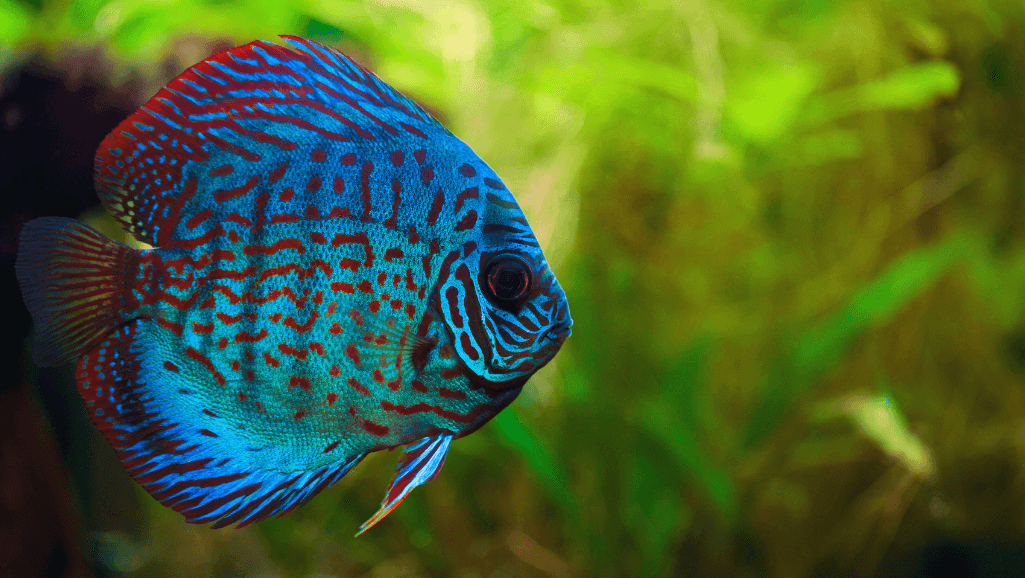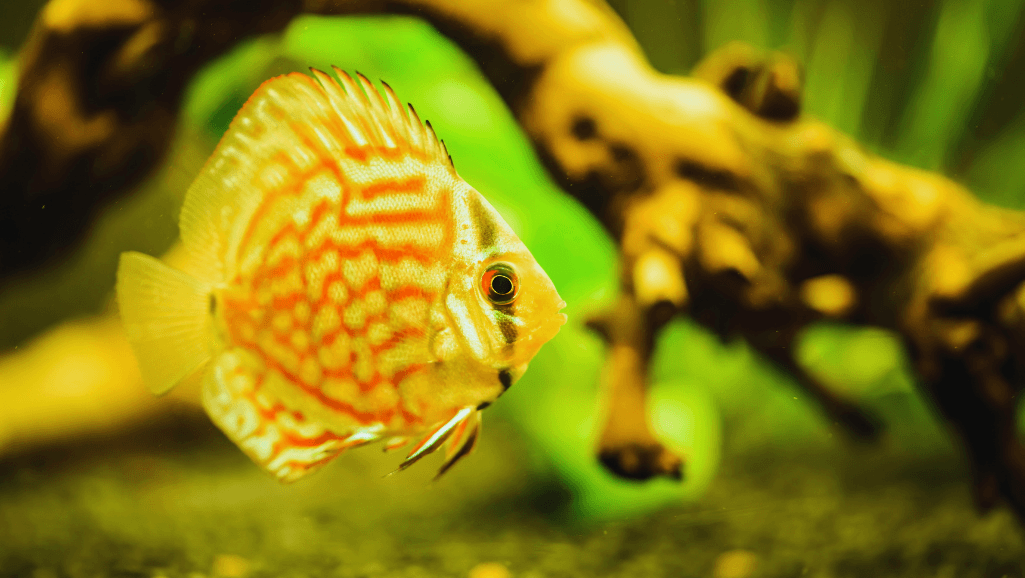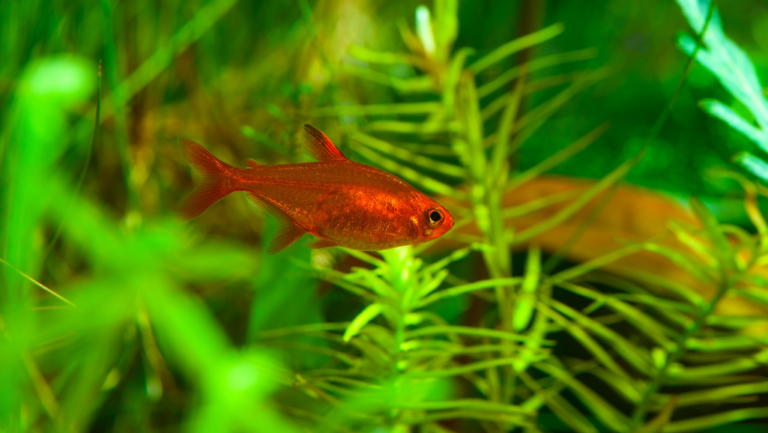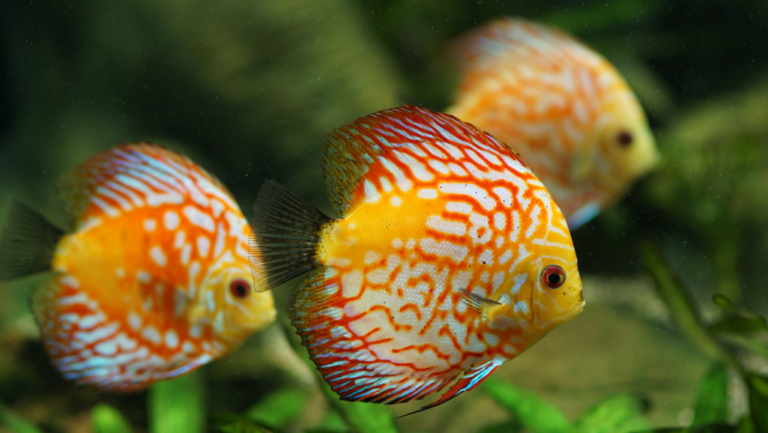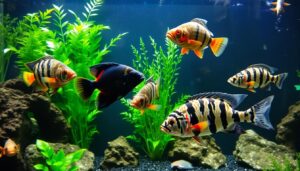Discus fish come from the Amazon basin and are loved by many. They are freshwater wonders with amazing colors and patterns. Their big, round shape and bright colors make them stand out in any tank.
Wild-caught discus, like the Half Royal Jaraqui, have beautiful patterns. They have deep blue stripes on a caramel and periwinkle background. These fish bring a piece of nature’s beauty to homes and offices. They are calm and have special size needs, perfect for those who want a peaceful tank.
To care for wild-caught discus, you need to mimic their natural home. They like warm water, between 85-86°F, and a pH of 6.8 to 7.6. They need a big tank, at least 75 gallons, to live happily in groups of 10 to 12.
Key Takeaways
- Wild-caught discus are prized for their natural beauty and colors
- They require specific water conditions mimicking the Amazon basin
- Large tanks are necessary to support their size and schooling behavior
- Discus fish prefer temperatures between 85-86°F
- pH levels should be maintained between 6.8 and 7.6 for optimal health
- Proper care is essential to recreate their natural habitat in aquariums
Introduction to Wild-Caught Discus
Wild-caught discus come from the Amazon basin. They are a favorite among aquarium fans for their stunning looks. These tropical fish give us a peek into the Amazon River’s underwater world.
The Allure of Amazonian Treasures
These fish come from untouched forest pools. They prefer water around 79°F and can grow up to 8 inches. With the right care, they can live up to 15 years, making great long-term pets.
Differentiating Wild-Caught from Captive-Bred Discus
Wild-caught discus face tougher conditions than their captive-bred friends. They might be more resilient. But, captive-bred discus often have better immunity. It’s possible to keep both, but you need to follow good aquarium care to make sure they get along.
Importance of Responsible Sourcing
It’s key to fish for wild-caught discus sustainably. This keeps their numbers healthy and supports the aquarium trade. Always buy from sellers who fish ethically.
| Aspect | Wild-Caught Discus | Captive-Bred Discus |
|---|---|---|
| Origin | Amazon basin | Fish farms |
| Water conditions | Murky, natural | Controlled, clean |
| Hardiness | Generally hardier | Varies |
| Immunity | Natural resistance | Potentially stronger |
| Care requirements | More specific | Adaptable |
Discus: The Kings of Freshwater Aquariums
Discus fish are the top choice for freshwater aquariums. They amaze people with their bright colors and interesting ways of acting. The wild-caught ones show the beauty of the Amazon basin.
Unique Characteristics of Wild Discus Species
Wild discus, like Symphysodon haraldi and S. aequifasciata, have special traits. They are better at taking care of their young than the ones kept in tanks. Their Amazon habits make them fun to watch in aquariums.
Popular Wild Variants: Royal Blues, Red Alenquers, and Green Discus
Among the wild ones, Royal Blues, Red Alenquers, and Green Discus are favorites. The Green Discus, also called Tefe Green or “Royal Red Spotted Greens,” are especially wanted. They have bright colors that remind us of the Amazon, adding beauty to well-kept aquariums.
Natural Habitat and Behavior in the Amazon Basin
The Amazon basin influences the behavior and care needs of wild discus. They need specific conditions to thrive, just like in their natural home. Knowing their habitat helps in caring for them in aquariums.
| Aquarium Factor | Recommendation |
|---|---|
| Tank Size (1-2 discus) | 10 gallons minimum |
| Water Temperature | Critical for health |
| Lighting | Replicate natural daylight |
| Plants | Anubias, Java Fern, Cryptocoryne wendtii variegata |
| Active Hours | Primarily during daylight |
By mimicking their natural conditions, aquarists can see the real behaviors of these amazing fish. It brings a piece of the Amazon into their homes.
Optimal Care for Wild-Caught Discus
Wild-caught discus are prized in the aquarium hobby. They need specific care to thrive. To mimic their natural habitat, keep water temperatures between 85-86°F (29-30°C). This helps their metabolism and immune system.
A 75-gallon aquarium or larger is best for 10-12 juvenile discus. This size reduces aggression and helps them school naturally. Proper tank setup is crucial for these delicate fish.
Water quality is key for wild-caught discus. They prefer a pH between 6.8-7.6 and soft to medium water hardness. Regular water changes are essential to keep the water pristine. For planted tanks, aim for nitrate levels below 40 ppm; for non-planted tanks, less than 20 ppm is best.
| Parameter | Ideal Range |
|---|---|
| Temperature | 85-86°F (29-30°C) |
| pH | 6.8-7.6 |
| Tank Size | 75+ gallons |
| Nitrate (planted) | <40 ppm |
| Nitrate (non-planted) | <20 ppm |
Nutrition is vital for these majestic fish. Feed them small foods like frozen bloodworms and Hikari Vibra Bites. Live or freeze-dried blackworms make great treats. Feeding small portions often helps them feel like they’re grazing naturally.
“Creating a stress-free environment is crucial for discus fish. Stable water conditions, reduced external stressors, and proper feeding contribute to their overall well-being.”
Adding air stones can increase oxygen levels, especially in warm tanks. With the right care, these wild-caught beauties will flourish, becoming the highlight of your aquarium.
Challenges and Rewards of Keeping Wild Discus
Keeping wild discus is both challenging and rewarding for aquarium lovers. These Amazonian beauties need special care to thrive in captivity.
Acclimation to Aquarium Life
Wild discus find it hard to adjust to aquarium life. They need large tanks with perfect water conditions. A 420-liter tank is best for 6 adult discus.
Keep the water temperature between 28°-30°C (82-86°F) for their health. During live fish transport, it might reach up to 32°C (90°F) for acclimation.
Parasite Management in Wild Specimens
Wild discus are often plagued by parasites, especially females. A 30-day quarantine in a bare tank is key before adding them to your aquarium. This helps prevent disease spread and supports sustainable fishing.
Breeding Considerations for Wild Discus
Breeding wild discus requires careful attention. Use breeding tanks that are 48 x 30 x 30 cm (19 x 12 x 12 inch) with bare bottoms and sponge filters. This setup makes maintenance easier and improves filtration.
| Parameter | Ideal Range |
|---|---|
| Temperature | 28°-30°C (82-86°F) |
| pH | 6.0-7.0 |
| GH | Less than 9 dGH |
| Tank Size (Adult Discus) | 420 liters for 6 fish |
| Water Changes | 50% weekly |
Following these guidelines helps aquarists overcome the challenges of keeping wild discus. They can then enjoy these magnificent fish in their home aquariums.
Conclusion
Wild-caught discus, prized tropical fish, offer a unique glimpse into the Amazon’s wonders. These fish, with their vibrant colors and behaviors, bring the Amazon to our homes. Keeping them requires dedication, knowledge, and a commitment to sustainable fishing.
Understanding their needs is key to their care. This includes water conditions and diet. While challenges like acclimation and parasite management exist, the rewards are great. Their presence in aquariums adds beauty and promotes awareness of Amazonian biodiversity.
Aquarists play a crucial role in conservation by supporting responsible sourcing. This ensures the longevity of wild discus populations. By doing so, they help preserve the Amazon’s ecosystem while enjoying these treasures in their aquariums.

